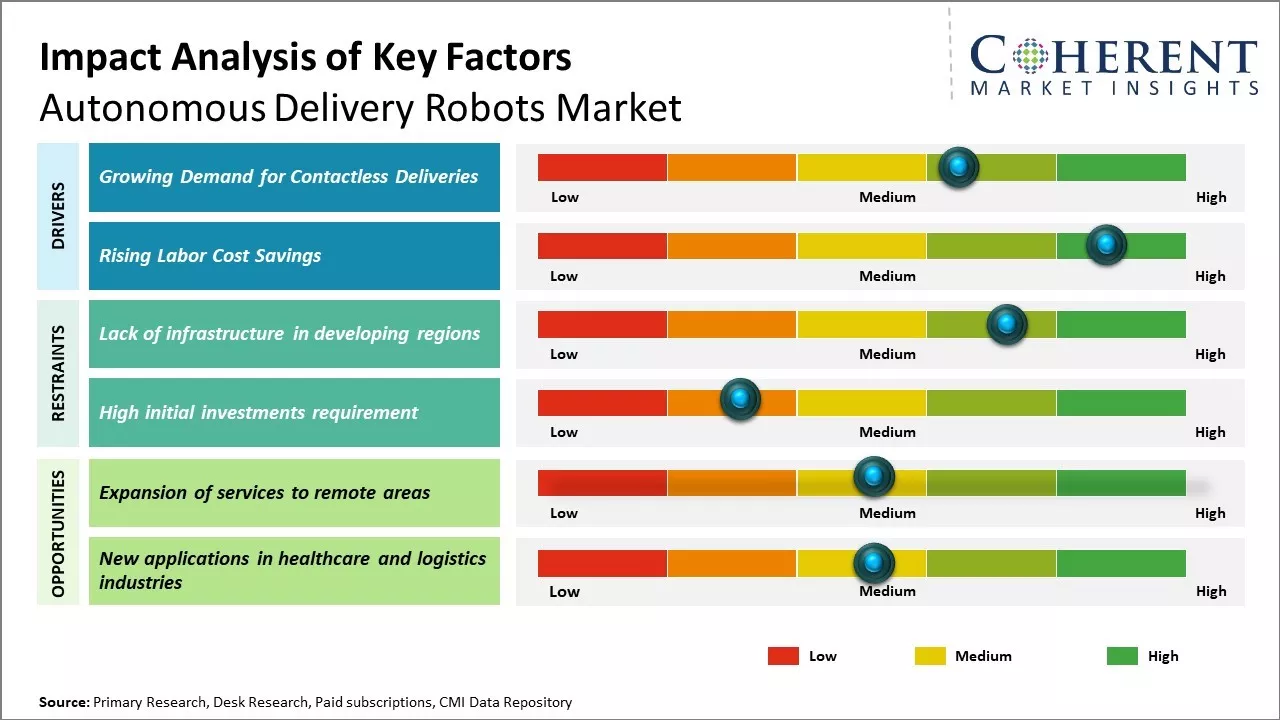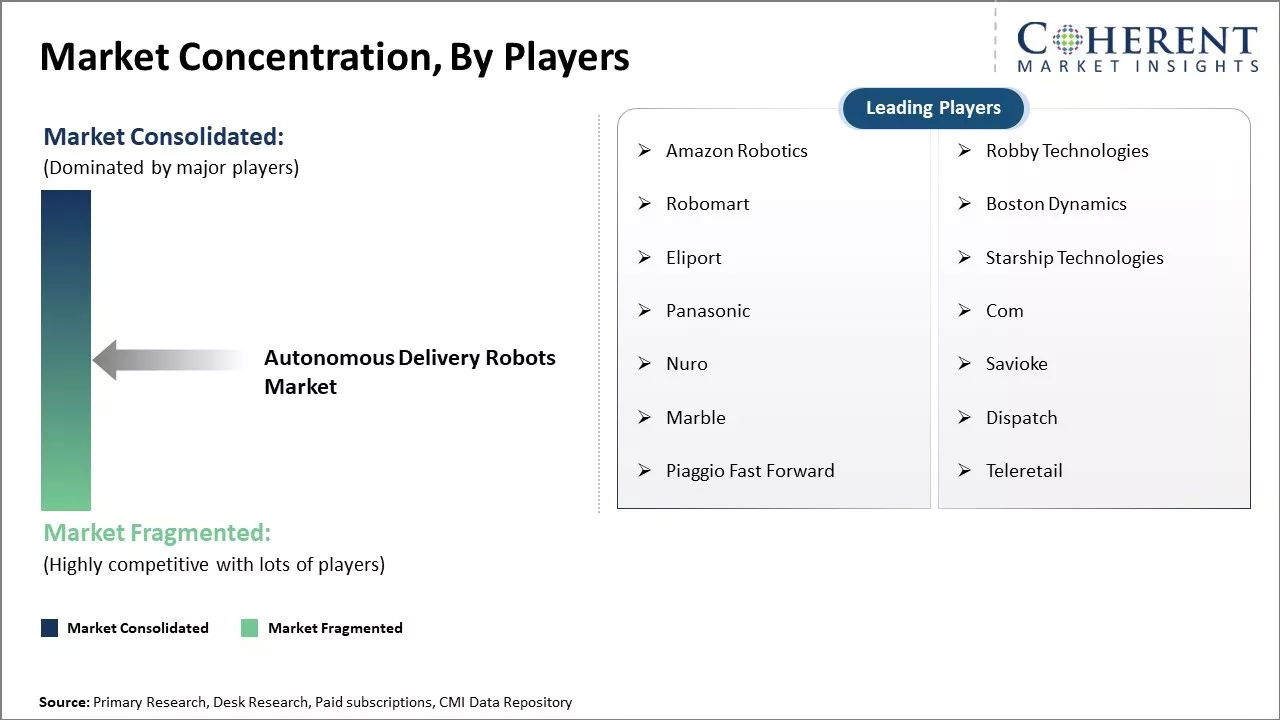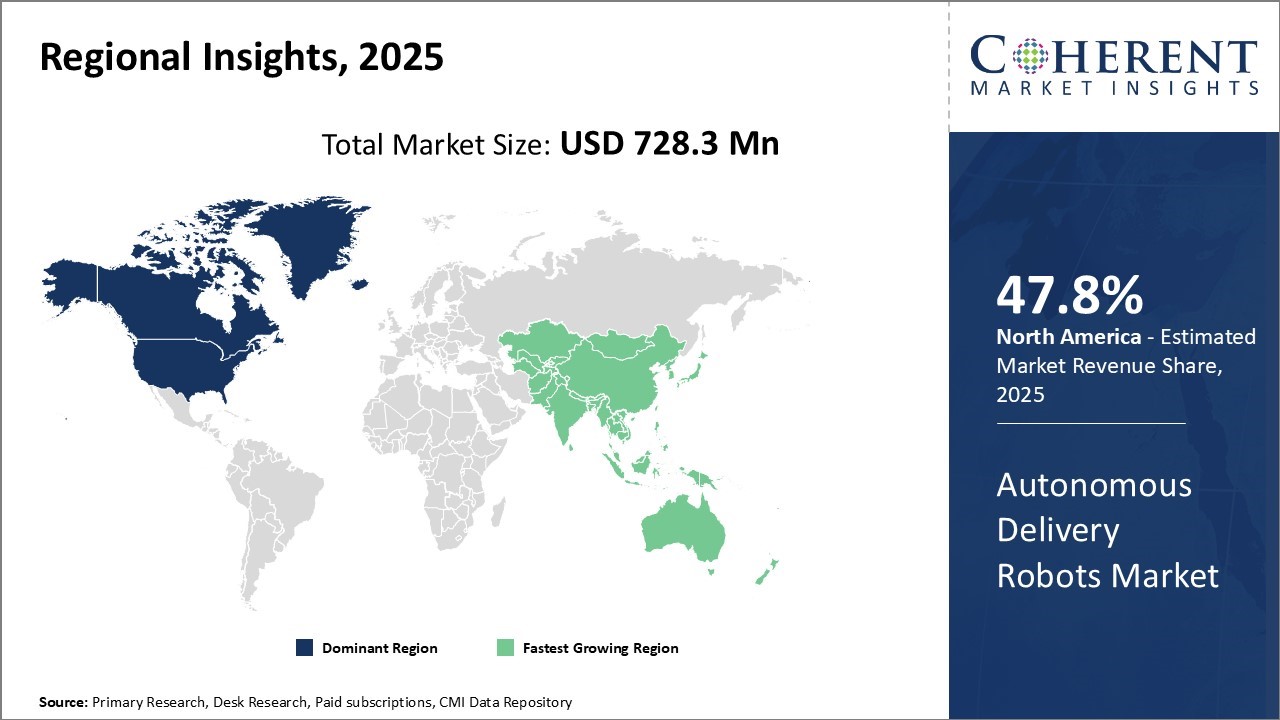The autonomous delivery robots’ market is estimated to be valued at USD 728.3 Mn in 2025 and is expected to reach USD 3,798.1 Mn by 2032, growing at a compound annual growth rate (CAGR) of 26.6% from 2025 to 2032.

To learn more about this report, Download Free Sample
The market for autonomous delivery robots (ADR) is expanding robustly worldwide, driven by growth in demand for contactless delivery, saving on labor costs, and improvement in navigation, sensor, and artificial intelligence technologies. ADRs are being rapidly embraced in the retail, logistics, health care, and food service industries, where last-mile delivery and operational efficiency are of utmost importance. These robots utilize integrated systems of LiDAR, GPS, cameras, and force sensors to drive autonomously in dynamic settings, such as city streets and indoor buildings. Advances in e-commerce, growing consumer demands for quicker deliveries, and a congested labor market in logistics are driving market adoption.
|
Current Events |
Description and its impact |
|
Retail Growth Drives Autonomous Delivery Robot Adoption into Last-Mile Logistics
|
|
|
AI-Driven Fleet Coordination to Speed Urban Rollout of Delivery Robots
|
|
Uncover macros and micros vetted on 75+ parameters: Get instant access to report
Emerging technologies play a primary role in the growth, functionality, and scalability of the Autonomous Delivery Robots (ADR) sector. The use of new technologies such as Artificial Intelligence (AI), Machine Learning (ML), LiDAR, computer vision, and cloud-based fleet management has transformed ADRs from simple mobile platforms to intelligent systems that can navigate real-world environments autonomously. Machine learning and AI are at the center of real-time decision-making and route optimization to enable the robot to learn to manage uncertain environments such as packed corridors, intersection of roads, and varying climatic conditions. Machine learning and AI also maximize object recognition and obstacle avoidance, reducing the chance of collision and enhancing delivery rates of completion.
Sensor fusion using LiDAR data, ultrasonic sensors, inertial measurement units (IMUs), and GPS allows ADRs to accurately position themselves and navigate indoors as well as outdoors. Computer vision, however, allows ADRs to detect and identify road signs, signals, and pedestrian behavior, which are important in the navigation of shared spaces. 5G network connectivity and cloud computing facilitate real-time monitoring, diagnostic, and remote control, while blockchain is being explored for delivery authentication and tracking chain-of-custody.
And energy-efficient batteries and self-docking stations are improving uptime and range of robots, making ADRs more feasible for use around the clock in urban logistics networks. All these technologies put together are not only augmenting robot brains and working efficiency but also costs over the long run, thus making commercial deployment of ADRs across various industries quicker.

To learn more about this report, Download Free Sample
Growing demand for contactless deliveries has accelerated the demand in the global autonomous delivery robots’ market as people aim to minimize human contact. Autonomous delivery robots can fulfill this demand by allowing deliveries to be made without any human involvement from warehouse to doorstep. Customers are now increasingly preferring deliveries be left at their door by robots rather than accepting packages from delivery agents. This ensures safety from infection and allows people to maintain social distancing norms.
Autonomous robots are programmed to safely navigate neighborhoods and traffic without putting themselves or others at risk. They can precisely detect sidewalks and pedestrian paths to follow regular delivery routes. Their cameras and sensors allow live monitoring of the delivery process to confirm packages are left at the right addresses.
This removes uncertainties and enables real-time tracking of shipments. The robot's compact size allows it to easily ferry packages to doors of residential buildings, apartments or office spaces without much difficulty. Contactless deliveries are becoming increasingly important for the elderly and high-risk populations who wish to minimize physical interaction during the pandemic.
The labor costs associated with manual deliveries have been steadily increasing over the years. Delivery businesses have to incur costs of employee salaries, medical benefits, insurance, transportation fees, and overtime compensations. Meanwhile, increasing e-commerce creates more stringent delivery windows calling for a larger fleet and staff. This situation has caused companies to increasingly look towards autonomous delivery robots as a promising means to contain their last-mile delivery expenditure.
Autonomous robots do not need wages, benefits, or overtime pay that constitute a significant portion of delivery costs. Autonomous robots operate continuously without extra expenses such as employee shifts or transportation. Remote control is affected through cloud-based technologies facilitating centralized monitoring of multiple robots.
In July 2024, Vayu Robotics, a San Francisco startup that launched its AI-driven delivery robot, Vayu One. Vayu One is different from conventional delivery robots that use costly LiDAR sensors, as it uses a transformer-based mobility foundation model in addition to capable passive sensors, which lowers hardware expenses considerably.
The secure logistics and e-commerce sectors are growing exponentially with demand for contactless deliveries rising amid pandemic scenarios. Successful demonstrations by pioneer companies have proven the technical and commercial viability. The costs are expected to reduce multi-fold with scaled production. Partnerships between robotics firms, retailers and restaurants are helping advance more practical solutions.
In 2024 Serve Robotics partnered with Uber Eats to expand robot-based food deliveries in Los Angeles, rolling out hundreds of semi-autonomous units that leverage AI and computer vision to navigate urban sidewalks.
In terms of type, fully autonomous is expected to contribute 61.9% of the market share in 2025 owing to significant technological advancements in robotics, automation, and artificial intelligence. Fully autonomous delivery robots have high-level capabilities without any human supervision. They utilize advanced navigation technologies like computer vision, GPS, Lidar, and other sensors to safely navigate complex environments and efficiently reach delivery destinations.
The rising demand for contactless delivery during the pandemic has further boosted investments in improving autonomous capabilities of robots. Leading companies are focusing on developing fully autonomous robots that can identify obstacles, read street signs, and interact with traffic signals and pedestrians on their own. The delivery efficiency and flexibility offered by full autonomy makes this segment highly attractive for merchants and customers.
In terms of carrying capacity, the 10.01-50kgs segment is expected to contribute 51.8% of the market share in 2025 due to its ability to handle growing delivery volumes efficiently. This capacity range allows robots to carry multiple packages in a single run based on optimal load distribution. They are suitable for delivering packages of varied sizes for food, grocery, retail and pharmacy applications. Their payloads are steady enough to replace complex manual transport over shorter distances.
Large merchants are inclined towards this category as it provides higher throughput in inner city and campus deliveries. The standardization in payload range also simplifies integration with warehouse management and order fulfillment systems.
In terms of number of wheels, the 4 wheels segment is expected to register 44.1% of the market share in 2025 owing to better maneuverability relative to tri- and six-wheel variants. Four-wheeled robots have a stable quadricycle or square design for navigating sidewalks, stairs, and other surfaces smoothly during deliveries. Their bidirectional driving and compact turning capability allow effortless movement in crowded areas.
The wheels are arranged strategically to lower the center of gravity for improved stability on uneven terrains. Most companies build 4-wheeled robots as they can be easily controlled using a single motor on each axle. The low-speed turning aids last-mile navigation without frequent stops or adjustments. Their agility enables quick response times, higher productivity, and excellent user experience.

To learn more about this report, Download Free Sample
North America has emerged as the dominant regional market. This region is expected to hold 47.8% of the market share in 2025 for autonomous delivery robots globally. The region has seen rapid adoption of automation technologies across various sectors including logistics & transportation. This is mainly due to heavy investments made by leading U.S.-based technology companies involved in the development of autonomous devices.
Major robotics and automation startups are based out of U.S. which gives the region an edge in terms of technology development and upgrades. Furthermore, countries like the U.S. and Canada have established regulations that allows testing and limited commercial use of autonomous robots on roads and sidewalks.
This enables companies to advance their robots through real world pilots and demonstrations. The large e-commerce industry in North America also contributes to the growing need for last-mile delivery solutions, creating more opportunities for autonomous delivery robots.
Asia Pacific, on the other hand, is witnessing the fastest growth in the adoption of autonomous delivery robots. This can be attributed to the rapid growth of online shopping and flourishing food delivery sector across countries like China, Japan, India and South Korea. The density of population and challenges of urbanization have increased dependency on cutting-edge technologies for efficient logistics.
Local startups as well as global players are therefore actively testing delivery robots customized for Asian roads and lifestyle. Governments of leading Asia Pacific nations are also offering incentives and relaxation in regulations to encourage the development and early commercial use of autonomous robots. This makes Asia Pacific an attractive market for both product trials as well as large scale commercial deployments of delivery robots over the coming years.
The U.S. dominates the ADR market owing to its robust technology ecosystem, penetration of e-commerce, and investment from key players such as Amazon, Starship Technologies, and Nuro. Broad pilot programs across cities and college campuses, along with favorable regulatory environments in certain states, have hastened adoption.
China is a leading ADR hub, fueled by fast-paced urbanization, a thriving online delivery market, and tech behemoths such as JD.com and Alibaba heavily investing in last-mile robotics. Beijing and Shenzhen are piloting autonomous delivery in scale, backed by government-supported smart city campaigns.
Germany leads the ADR adoption in Europe, thanks to its strong manufacturing base and industrial automation focus. Players such as DHL and Hermes are already experimenting with ADRs for parcel delivery, and robust regulations regarding autonomous systems are promoting safe deployment.
The U.K. has experienced rapid take-up of ADRs, notably in town and university environments. Organizations such as Starship Technologies have introduced popular pilot schemes in areas such as Milton Keynes through the backing of local authorities and an advanced delivery infrastructure.
| Report Coverage | Details | ||
|---|---|---|---|
| Base Year: | 2024 | Market Size in 2025: | USD 728.3 Mn |
| Historical Data for: | 2020 To 2024 | Forecast Period: | 2025 To 2032 |
| Forecast Period 2025 to 2032 CAGR: | 26.6% | 2032 Value Projection: | USD 3,798.1 Mn |
| Geographies covered: |
|
||
| Segments covered: |
|
||
| Companies covered: |
Amazon Robotics, Robby Technologies, Robomart, Boston Dynamics, Eliport, Starship Technologies, Panasonic, Com, Nuro, Savioke, Marble, Dispatch, Piaggio Fast Forward, and Teleretail |
||
| Growth Drivers: |
|
||
| Restraints & Challenges: |
|
||
Uncover macros and micros vetted on 75+ parameters: Get instant access to report
Share
Share
About Author
Gautam Mahajan is a Research Consultant with 5+ years of experience in market research and consulting. He excels in analyzing market engineering, market trends, competitive landscapes, and technological developments. He specializes in both primary and secondary research, as well as strategic consulting across diverse sectors.
Missing comfort of reading report in your local language? Find your preferred language :
Transform your Strategy with Exclusive Trending Reports :
Frequently Asked Questions
Joining thousands of companies around the world committed to making the Excellent Business Solutions.
View All Our Clients